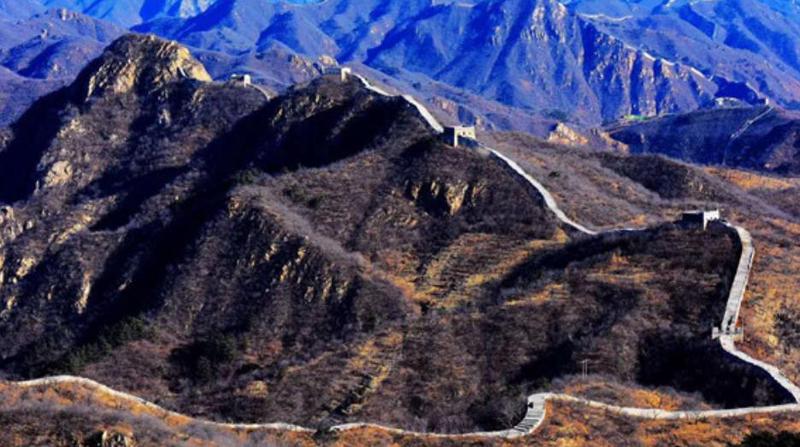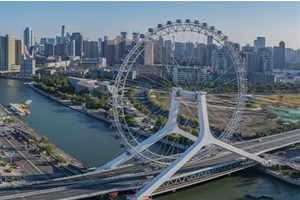An important node on the Beijing Great Wall Cultural Belt, an important node on the Beijing Great Wall Cultural Belt!
During the summer vacation, many tourists welcome to the scenic spots related to the Great Wall in Beijing, and Mutianyu Great Wall is no exception. Mutianyu Great Wall connects Juyongguan in the west and Gubeikou in the east, which is magnificent and imposing. The famous Great Wall landscape, such as the horn edge and the eagle flying backwards, is located on the west side of Mutianyu Great Wall, which is the essence of the Great Wall in Ming Dynasty.
Mutianyu was once called "the Valley of Skyscrapers". Standing on the closed platform and looking up, the Great Wall seems to reach the sky, so it is called "the Skyscraper". "Skyscraper" is similar to "Mutian", while "Valley" and "Valley" are common holidays, and later it was called Mutianyu. Standing on the Mutianyu Great Wall, looking up at the top of the mountains, the blue-gray wall is connected with the ups and downs of the ridge, which is full of three-dimensional sense. In the past 600 years, this military stronghold guarding the capital has been called "Dangerous Ridge and Xiongguan" and won the reputation of "Mutianyu, the Great Wall of Wan Li". Nowadays, the Mutianyu Great Wall, as a world cultural heritage scenic spot for five years, has changed from a big wall to a unique human landscape. Through the clouds of history, we deeply feel the changes of the past years and the vicissitudes of the years.
According to historical records, Mutianyu Great Wall was rebuilt by Xu Da, a general in the early Ming Dynasty, on the Great Wall of Northern Qi Dynasty. At the end of the Yuan Dynasty, Xu Da joined the uprising army led by Zhu Yuanzhang. In the twenty-seventh year of Yuan Zhizheng (1367), Xu Da was appointed as a general of Lu, and together with Chang Yuchun, a deputy general, he made a northern expedition to the Central Plains and captured the capital of Yuan Dynasty. In 1368, Zhu Yuanzhang founded the Ming Dynasty with the title Hongwu. After the founding of the People's Republic of China, Xu Da sent troops to fight against the forces of the Northern Yuan. At that time, there was a triangle city outside the Mutianyu Pass, and there was a record in The Chronicle of the Ming Dynasty that "Xu Da was defeated here". In the fourth year of Hongwu, Xu Da was ordered to go to Beiping to practice his army, repair the city and open up wasteland. In the meantime, the construction of Mutianyu Great Wall has been clear and has begun to take shape. Therefore, Pan Qican, a scholar in the Qing Dynasty, once wrote a poem in his poem "Climbing the River to Defend the Border Town" that "the fortress was spread to Wei, and the platform was built to say Nantang". Xu Da was wise and brave, disciplined in the management of soldiers, and modest and prudent. He was able to share the joys and sorrows with his subordinates, marched prudently, and did not kill rashly. All the men were grateful and died, so he made outstanding achievements and was the first founding hero in the early Ming Dynasty.
Mutianyu Great Wall is the second Great Wall scenic spot in Beijing after Badaling Great Wall. The author has consulted relevant archival materials. In the autumn of 1981, when experts demonstrated the location of the Great Wall scenic spot, they thought that Mutianyu Great Wall had three advantages: first, it was close to the capital Beijing, with gentle roads and convenient transportation; Second, the Great Wall is magnificent, with dense watchtowers and crenels on both sides; Third, the vegetation is intact and the forest coverage rate is high. After listening to everyone's opinions, Chen Muhua, then Vice Premier of the State Council, made a final decision to make Mutianyu the second tourist opening point of the Great Wall in Beijing.
When people visit Mutianyu Great Wall, they generally like to take a cable car to the 14th enemy building. The interior of No.14 watchtower is a hollow zigzag structure, commanding, with arrow windows on all sides. Looking at other watchtowers, they all have their own characteristics. Some of their internal structures are zigzag, some are well-shaped and some are pin-shaped. The shape is different, the arrow window is different, and some watchtowers have been restored. The terrain near No.14 watchtower is relatively flat, with lush vegetation and wide vision. But sometimes lingering here often ignores Zhengguan Station and misses the opportunity to watch the extraordinary Mutian Valley Pass.
Mutianyu Great Wall is different from other sections of the Great Wall because it is a double-sided crib, because it is the northern barrier of the capital and the imperial tombs. Because the Ming Tombs are only 39 kilometers away from here, this section of the Great Wall has been built firmly. The construction of double battlements on the city wall is due to the need to attack and defend well and defend against the enemy on both sides. Both sides of the crib can carry out two-way defensive operations at the same time, and cooperate with the supporting city to form a potential of attack and effectively kill the enemy. These crenels are not rectangular with openings, but serrated. The shooting hole is built under the crib mouth. It is not a circular hole, but a square hole with an arc top.
As a defense project, the Great Wall is mainly composed of castles, gates, city walls and beacon towers. The pass is an important garrison base along the Great Wall, and its location is mostly chosen on the throat of the Great Wall. In fact, there is a difference between pass and pass. Pass is also called pass and pass, which is a mountain pass and pass leading to a region, emphasizing the existence of military facilities. Mouth, which is the place that must pass through when going through customs and entering the fortress, is usually related to trade. The definition of "Reading Historical Records" is that "the avenue is the gateway and the path is the mouth. The troops are stationed in the camp, and they are stationed in the village. " However, in the long-term evolution of the Great Wall Pass, emotional factors have been gradually added. People are used to calling the outside of the enemy close to the door as the pass, and the inside of the face as the mouth, so the mouth outside the mouth is to talk to themselves, and the inside of the pass is to talk to the outside. In this way, the meaning of the pass has a new content. There are only three passes in Huairou, namely Dashuiyu Pass, Mutianyu Pass and Huanghua Chengguan.
The wall of Mutianyu Great Wall is mostly built on the steep cliff outside, depending on the mountain to take advantage of the situation and control the situation with danger. Just west of Guantai, from Muzi 4 to Muzi 20 to the highest point on the horn side, it jumped 104 meters and set up 26 enemy towers. The height of the wall is seven or eight meters, and the top of the wall is four or five meters wide. The building material is mainly granite, which is majestic and solid. The Great Wall extends straight from the mountainside to the top of the mountain. After an enemy tower is erected on the mountainside, it suddenly descends, turns down and returns to the mountainside, and suddenly rises again. At an altitude of more than 940 meters, it turns around a big bend, which looks like an ox horn and is vigorous and vigorous. People call it "the ox horn edge". On both sides of the "ox horn edge", there is a section of the Great Wall called "arrow buckle" and "eagle flying upside down". The walls of this section of the Great Wall are all built on the exposed cliffs. Most of the slopes of the Great Wall are about 50 degrees, and one section of it is close to 90 degrees, almost vertical, and the steps are only a few inches wide, so those who are not brave dare to set foot in it. The eagle flying upside down is one of the most famous dangerous sections of the Great Wall in Beijing. People who have been to the arrow buckle will use the word "eagle flying upside down" to describe the precipitousness and danger of this section of the Great Wall. Similarly, this section of the Great Wall is also the section with the highest photogenic rate in the Great Wall picture book in recent years, and it is a hot spot for the challenge of donkey friends and photographers.
Dajiaolou is now named Mu Zi, which is one of the famous landscapes of Mutianyu Great Wall. From the big turret to the south, there is also a "branch city". The so-called "supporting the city" is to build a section of the Great Wall along the ridge where there are high ridges on the inside and outside of the Great Wall. Its length varies from a few meters to tens of meters, and there is an enemy tower built here. The locals call it the "knife handle building", and this section of the Great Wall is also called "the bald tail side". The purpose of building this branch city is to control the commanding heights and reduce the threat to the main city.
Strolling in Beigou Village at the foot of the Great Wall seems to have crossed time and space. The antique Chinese courtyard here is full of ancient mystery. The light and simple Nordic hut exudes the purity of the ice sheet; Simple and serious German-style villas condense the solemnity of Central Europe ... The "contrast" of unique elements in more than ten countries and the "mix and match" of different architectural styles have produced amazing artistic impact and attracted tourists from all over the world. This remote and isolated mountain village in the past has now become an "international village" full of foreign styles.






